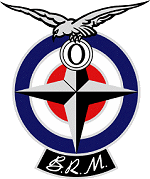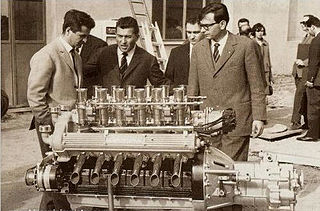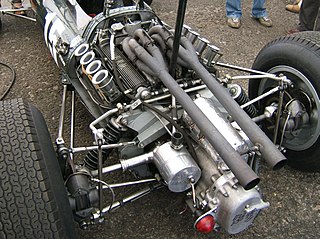
A V12 engine is a twelve-cylinder piston engine where two banks of six cylinders are arranged in a V configuration around a common crankshaft. V12 engines are more common than V10 engines. However, they are less common than V8 engines.

Cosworth is a British automotive engineering company founded in London in 1958, specialising in high-performance internal combustion engines, powertrain, and electronics for automobile racing (motorsport) and mainstream automotive industries. Cosworth is based in Northampton, England, with facilities in Cottenham, England, Silverstone, England, and Indianapolis, IN, US.

British Racing Motors (BRM) was a British Formula One motor racing team. Founded in 1945 and based in the market town of Bourne in Lincolnshire, it participated from 1951 to 1977, competing in 197 grands prix and winning seventeen. BRM won the constructors' title in 1962 when its driver Graham Hill became world champion. In 1963, 1964, 1965 and 1971, BRM came second in the constructors' competition.

The DFV is an internal combustion engine that was originally produced by Cosworth for Formula One motor racing. The name is an abbreviation of Double Four Valve, the engine being a V8 development of the earlier four-cylinder FVA, which had four valves per cylinder.

The 1966 Italian Grand Prix was a Formula One motor race held at Monza on 4 September 1966. It was race 7 of 9 in both the 1966 World Championship of Drivers and the 1966 International Cup for Formula One Manufacturers. The race was the 36th Italian Grand Prix and the 32nd to be held at Monza. The race was held over 68 laps of the five kilometre circuit for a race distance of 391 kilometres.

The Lamborghini V12 refers to the flagship V12 engine used by Lamborghini. Lamborghini has had two generations of V12 engines through their history, both of which were developed in-house. The first-generation Lamborghini V12 was a sixty degree (60°) V12 petrol engine designed by Lamborghini, and was the first internal combustion engine ever produced by the firm.
Weslake & Co also known as Weslake Research and Development was founded by Harry Weslake, described as England's greatest expert on cylinder head design, with premises in Rye, East Sussex, England. Weslake is most famous for its work with Bentley, Austin, Jaguar and the Gulf-Wyer Ford GT40 Mk.I.

The Lotus 43 was a Formula One racing car designed by Colin Chapman for the 1966 season. Hampered by its heavy and unreliable BRM engine, it won only one race, the 1966 United States Grand Prix.

The Lotus-Ford Twin Cam is an inline-four petrol engine developed by Lotus for the 1962 Lotus Elan. A few early examples displaced 1.5 litres, but the majority were 1.55-litre (1557ml) engines. It used a Ford 116E iron cylinder block and a new aluminium cylinder head with dual overhead camshafts. The Twin Cam was used in a variety of vehicles until Lotus stopped production in 1973. It was succeeded by the Lotus 907 engine.

The Eagle Mk1, commonly referred to as the Eagle T1G, was a Formula One racing car, designed by Len Terry for Dan Gurney's Anglo American Racers team. The Eagle, introduced for the start of the 1966 Formula One season, is often regarded as being one of the most beautiful Grand Prix cars ever raced at the top levels of international motorsport. Initially appearing with a 2.7L Coventry Climax inline 4-cylinder engine, the car was designed around a 3.0L Gurney-Weslake V12 which was introduced after its first four races. In the hands of team boss Gurney, the Eagle-Weslake won the 1967 Belgian Grand Prix, making Dan Gurney only the second driver at the time, and one of only three to date, to win a Formula One Grand Prix in a car of their own construction. Excluding the Indianapolis 500, that win in Belgium still stands as the only win for a USA-built car as well as one of only two wins of an American-licensed constructor in Formula One. It was also the first win for an American constructor in a Grand Prix race since the Jimmy Murphy's triumph with Duesenberg at the 1921 French Grand Prix.

The Brabham BT19 is a Formula One racing car designed by Ron Tauranac for the British Brabham team. The BT19 competed in the 1966 and 1967 Formula One World Championships and was used by Australian driver Jack Brabham to win his third World Championship in 1966. The BT19, which Brabham referred to as his "Old Nail", was the first car bearing its driver's name to win a World Championship race.
This article gives an outline of Formula One engines, also called Formula One power units since the hybrid era starting in 2014. Since its inception in 1947, Formula One has used a variety of engine regulations. Formulae limiting engine capacity had been used in Grand Prix racing on a regular basis since after World War I. The engine formulae are divided according to era.

A V8 engine is an eight-cylinder piston engine in which two banks of four cylinders share a common crankshaft and are arranged in a V configuration.

The BRM P261, also known as the BRM P61 Mark II, is a Formula One motor racing car, designed and built by the British Racing Motors team in Bourne, Lincolnshire, England. The BRM P261 was introduced for the 1964 Formula One season, and its design was an evolution of Tony Rudd's one-off BRM P61 car of 1963. The P261 had a relatively long racing career; variants of the car were still being entered for Formula One World Championship Grands Prix as late as 1968. During the course of their front-line career, BRM P261s won six World Championship races, in the hands of works drivers Graham Hill and Jackie Stewart, and finished second in both the Drivers' and Constructors' Championship standings in 1964 and 1965. Stewart, Hill and Richard Attwood also used works P261s to compete in the Tasman Series in 1966. The BRMs dominated, with Stewart winning four, Hill two, and Attwood one of the 1966 Tasman Series' eight races. Stewart also won the title. The works-backed Reg Parnell Racing team returned in 1967 with Stewart and Attwood, where Stewart added another two wins to his tally. In terms of races won and total championship points scored, the P261 was the most successful car in BRM's history.

The Honda RA271 was Honda's first Formula One racing car to enter a race. The chief engineer on the project was Yoshio Nakamura, with Tadashi Kume in charge of engine development. It was driven in three races during 1964 by American driver Ronnie Bucknum.
The BRM P115 was a Formula 1 racing car built by British Racing Motors in 1967.

The BRM P83 was a Formula One racing car designed by Tony Rudd and Geoff Johnson and built by British Racing Motors for the new engine regulations of 1966. It used a highly unorthodox H16 engine which caused problems throughout the car's racing life, and despite the best efforts of Graham Hill and Jackie Stewart took BRM from championship contenders to also-rans, leading it to be regarded alongside the BRM Type 15 as another embarrassing failure for the British marque caused by overcomplicated engineering.
The Weslake V12 engine family is a series of four-stroke, 60-degree, naturally-aspirated, V-12 racing engine, designed, developed and produced by Weslake; between 1966 and 1992.
The Lotus 42 is an open-wheel race car built by Team Lotus for the 1967 Indianapolis 500. The car was unsuccessful that year, with Graham Hill retiring on lap 23 of the race.

The British Racing Motors V8 was a four-stroke, naturally aspirated, 1.5 L (92 cu in), V-8 racing engine, designed, developed and built by British Racing Motors (BRM) to compete in Formula One racing (although an enlarged 2.0 L version was used for sports car racing. It was built between 1962 and 1967, and came in two version; the P56, and the P60.














